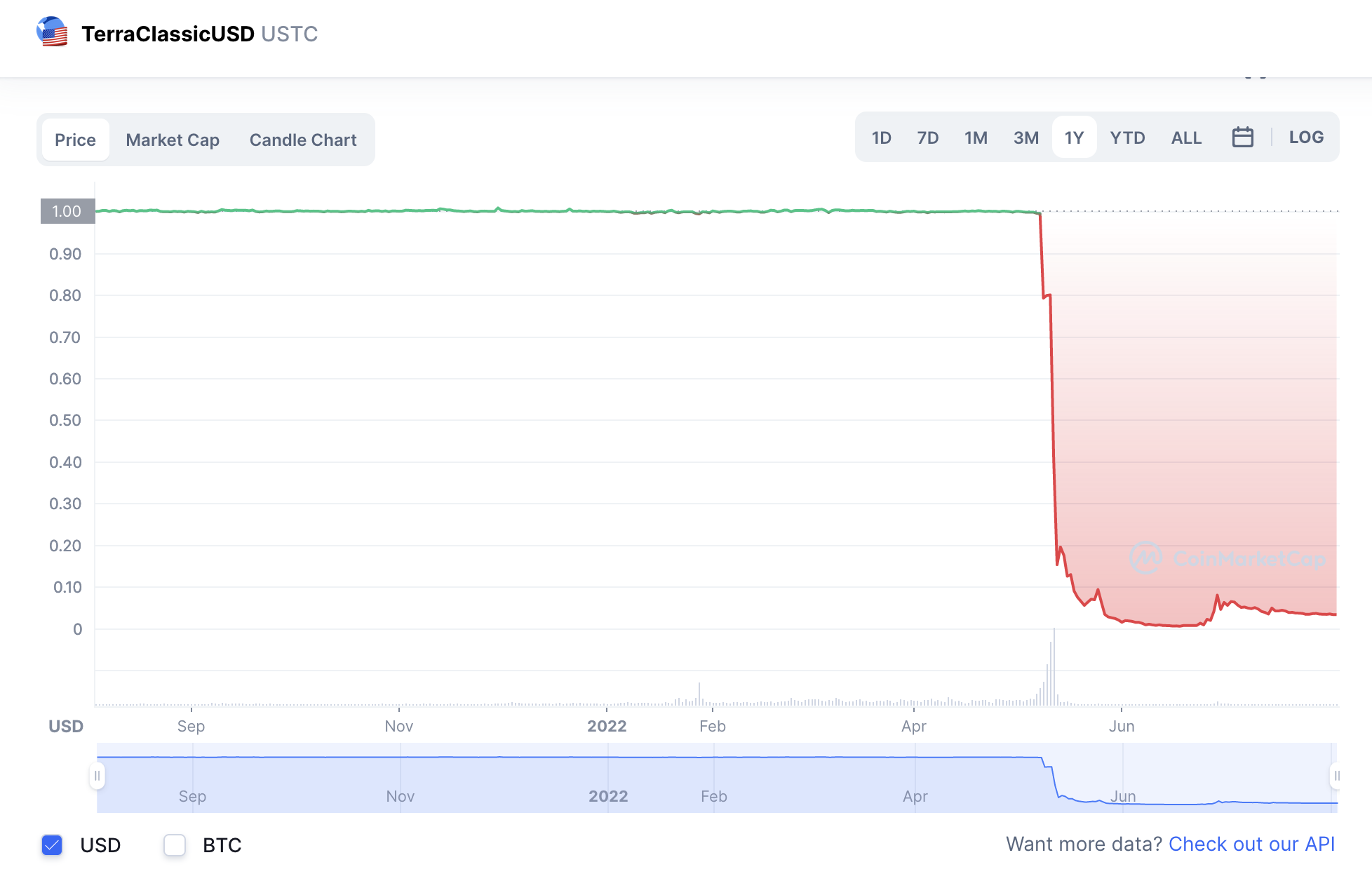The global economic engine is sputtering as it tries to move forward under a heavy burden – a war in Ukraine, mass supply chain disruption, questions about food security, a global pandemic still with grave consequences and the highest inflation in 40 years.
As the smoke clears from the recent stock market and cryptocurrency whirlwind, it’s important to digest and clarify what happened. The spectacular crash of the UST stablecoin and LUNA, its sister token, has raised many questions if the crypto equivalent of stable assets – stablecoin – can be trusted. Crypto has mass appeal now, but it’s only been around since 2009 and people are still learning the ropes so here is what you need to know.
What is a stablecoin?
The term ‘stablecoin’ has now gone mainstream, and it was probably the first time many had heard of it. A stablecoin is a digital asset that aims to maintain the same value as a stable asset, or basket of assets. The US dollar has been the most common asset to date.
The idea behind stablecoins is to combine the technical capabilities of digital assets while providing an alternative to the price volatility that has historically been characteristic of major cryptocurrencies like bitcoin and ether.
That means you can take advantage of the benefits of blockchain technology – traceability, the ability to engage in smart contracts, etc – while maintaining a stable price.
But, not all stablecoins are equal – so here are four categories of stablecoin:
Fiat-backed: Stablecoin issuers hold 1:1 reserves of fiat currency. The total value matches how much they have backed by fiat.
Crypto-backed: These stablecoins are backed by other cryptos via smart contracts rather than a service provider. They are “over-collateralized” meaning the value of the crypto backing exceeds the value of stablecoins issued, in order to account for price fluctuations.
Commodity-backed: Similar to fiat-backed stablecoins, stablecoin issuers hold equivalent values of commodities like precious metals, oil and real estate. The coins may or may not be redeemable for the physical asset.
Algorithmic: These stablecoins are not backed. Instead, they aim to maintain a stable value through algorithms and smart contracts that manage the expansion and contraction of token supply.
All of these coins have one characteristic in common: they all target a specific price. The thinking goes: “if the price doesn’t change much, that would make a coin stable”.
Big mistake.
First of all, when a specific price is targeted that means that any time price moves away from that target, an organization tasked with maintaining the price stability will use their predetermined process to force the price in another direction. Historically that is how any price peg is maintained. And as we all know pegs have tendencies to be broken. It becomes a game of who has more resources, people that are trying to break the peg and people that are trying to defend it. But that is not even the main problem with targeting a specific price level.
Stability in itself should be viewed as a valuable resource, and the value of any market resource is changing based on the demand. When volatility is up or inflation increases (reduced stability in the world financial markets) demand for stable asset would increase, and when volatility is decreasing and there is no threat of runaway inflation – demand for stability goes down. These market forces make stable assets more stable, it regulates their supply and makes such assets productive.
A great example of a stable asset is gold, and gold price moves around. It is determined by market forces and the perceived stability of the global financial system. The dollar is another example. It’s ironic that many stablecoins are trying to target a price equal to one dollar, but the price of the dollar itself (as stable as it is) moves around against other currencies and other factors but let’s not get into that…
Targeting a specific price actually makes stable cryptocurrency less stable. As demand for stable assets increases or decreases it puts pressure on whatever stabilization mechanism that currency is using.

As far as the four known categories of stable cryptocurrencies, there are examples of all of them having problems.
Cryptocurrencies backed by fiat currencies are probably the best know “stable” cryptocurrencies. Tether and TrueUSD are good examples of this category, but Tether specifically is used not because of its stability, it is used as a US dollar substitute by many crypto exchanges. Exchanges are afraid of dealing in USD directly because they don’t want to answer to US regulators and they all use USDT instead. As with any asset-backed token, the dollar-backed currency is as stable as the dollar itself, as long as the relationship between the underlying asset and the token is transparent and safe. Even though Tether is in demand, the shortcomings of the dollar-backed tokens are obvious, creating cryptocurrency backed by a fiat currency means that the coin’s ecosystem has to be plugged into a traditional banking system to hold the underlying fiat currency at best with a centralized custodian. And we all know how inflation is behaving right now…
Crypto-collateralized (Decentralized) – The biggest risk to this stablecoin model is the volatility of the underlying collateral. If the collateral loses too much value, the system become under-collateralized and fallback procedures could be enabled, such as stablecoin liquidation.Ultimately, collateral portfolio volatility determines crypto-collateralized stability. As a result of cryptocurrency and collateral volatility, crypto-collateralized stablecoins require over-collateralization so that fluctuations in collateral values can be absorbed.
A good example of a “stable” coin backed by crypto collateral (Crypto-backed stablecoin) is Dai by MakerDAO. The market cap is growing, it stands at just over 40 million USD. Dai seems to be pretty stable so far, but to achieve that stability, Maker is over-collateralizing its tokens. That process makes the stable currency expensive and whether it will be able to significantly grow its market share remains to be seen.
Commodity-backed stablecoins
Holders of commodity-backed stablecoins are essentially exposed to the value of a real-world asset. These assets have the potential to appreciate — or depreciate — in value over time, which can affect the incentives for trading these coins.
Digix Gold (DGX), for example, is an ERC-20 token (built on the Ethereum network) backed by physical gold, where 1 DGX represents 1 gram of gold. This gold is stored in a vault in Singapore and gets audited every 3 months. The creators of DGX claim they have “democratized access to gold.” DGX holders may even redeem their coins for physical gold — they just have to go to the vault in Singapore to do so.
Given the fact that the value of the real-world assets is also pretty volatile these days we no longer can count on scarcity.. As soon as someone digs in some gold and the price starts to fluctuate.
Now, the algorithmic stablecoin…
An algorithm can be an obfuscating word. But it simply means a set of code that instructs a process.
Algorithmic stablecoins typically rely on two tokens – one stablecoin and another cryptocurrency that backs the stablecoins – and so the algorithm (or the smart contract) regulates the relationship between the two.
Here is one fresh example:
TerraUSD (UST) maintains – or is supposed to maintain – its 1:1 parity with the U.S. dollar via an algorithmic relationship with Terra’s native cryptocurrency, LUNA. Behind the relationship is an arbitrage opportunity that presents itself every time UST loses its peg in either direction.
When the UST supply is too small and demand for it is too high, the price of UST goes above $1. To bring UST back to its peg, the Terra protocol lets users trade 1 USD of LUNA for 1 UST at the Terra station portal. This trade burns 1 USD of LUNA and mints 1 UST, which users can sell for 1.01 USD and pocket a profit of 1 cent. It doesn’t sound like a lot, but these profits add up when done in large quantities.
Users can mint as much UST as needed from burned LUNA until UST goes back down to $1. As the supply increases, the price eventually comes down – or that’s at least the logic behind it.
When the supply is too large and demand is too low, the opposite happens.
The second scenario – value falling below the peg – is a more common problem for algorithmic stablecoins, as the market anxiety around them is more common than market euphoria, resulting in more instances of lower demand and higher supply.
UST’s algorithmic relationship with LUNA means that the latter has to absorb the volatility of the former. Since new LUNA can be continuously minted any time UST is below $1, the price of LUNA can free-fall in the face of increasing token supply.
How did UST de-peg in May 2022? – First slowly, then suddenly.
UST began de-pegging on May 7, as large-volume withdrawals from Terra’s largest decentralized finance (DeFi) protocol Anchor began in earnest. These had a domino effect on the UST pool on Ethereum’s Curve Protocol, the main hub for stablecoin liquidity in all of DeFi, which also saw high-volume withdrawals.
Some blame the events that led to UST’s de-pegging on a coordinated attack. Others think it was a series of spontaneous panic-ridden withdrawals due to the souring wider market conditions, especially in the price of bitcoin that LFG has added to its reserve to back UST. In either case, the stablecoin hasn’t withstood the pressure enough to maintain its peg, eventually falling as low as $0.29 on May 11.

But isn’t this where the algorithm should work its magic?
The algorithm, which is supposed to burn UST and mint LUNA when UST is below $1, hasn’t worked as well; it’s failed to keep up with the extreme conditions. The algorithm couldn’t facilitate the minting of new LUNAs at a speed needed to re-peg UST (it had to outrun the market speed, and it couldn’t).
That raised a lot of questions about the actual stability of stablecoins.
Final thoughts:
So how can a stable cryptocurrency be created, or what could make a cryptocurrency stable? In short, a truly stable cryptocurrency has to have its own stability and not rely on another asset or another coin to maintain its price. A stable crypto ecosystem has to be created and a cryptocurrency that is an integral part of it will be as stable as the ecosystem itself.
So, what will a real stable cryptocurrency look like? Here’s my list of attributes:
- It will run on its own blockchain that is a well-understood and safe
- It will support a large ecosystem with a stable and significant number of daily transactions.
- The value of this currency will have a direct correlation to the size of its network
- It will not be backed by any other asset
- The price of this currency will be allowed to fluctuate based on supply, demand, market sentiment, etc.
- The value will not depend on gimmicks like token burning, etc.



